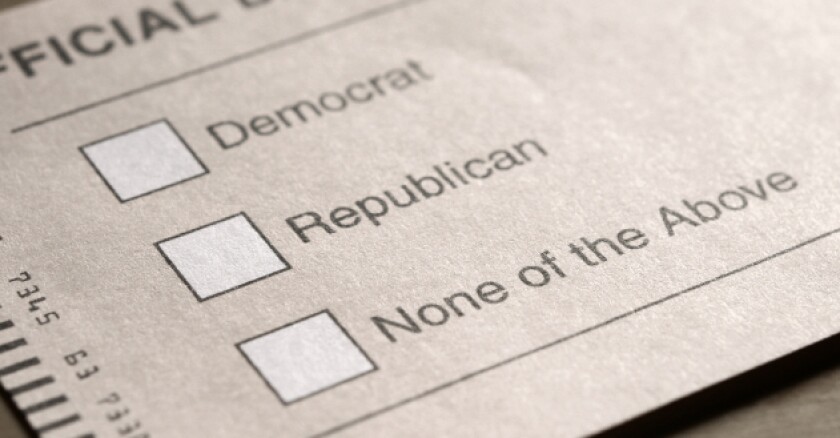Increasingly, local election authorities are turning to ballot marking devices or recommitting to paper ballots marked by hand. In 2022, 92.2 percent of voters will live in a jurisdiction using one of these voting methods.
In the 2012 midterms, about one-third of voters lived in jurisdictions using these machines, but they have fallen out of favor across the board. This year, 7.5 percent of voters live in a jurisdiction that uses them, according to data compiled by Verified Voting.
In 2018, the National Academies of Sciences, Engineering and Medicine published a consensus report which recommended exclusively using paper ballots or electronic ballot marking devices because of the cybersecurity risks of recording votes directly into electronic memory.
“There is a push to audit more elections,” said Thomas Bride, executive director of the Peoria County Election Commission. “That’s easier to do with a paper-based system.”
Peoria now uses paper ballots and Hart InterCivic’s Verity Scan device, which has voters feed their ballot into a scanner. In addition to facilitating post-election audits, Bride believes the new system will help the county in other ways.
“We wanted to make sure any system we got would grow,” said Bride, who added that the system makes handling mail-in ballots easier since it follows a similar process to in-person votes.
Kenny Barger, the county clerk in Madison County, Ky., oversaw the full rollout of Election Systems & Software (ES&S) ExpressVote machines, a ballot marking device, for the state’s May primaries. Madison County has used the machines in some capacity for several years but recently expanded their use.
“Your upfront costs are higher, but the ROI is short,” said Barger.
Barger said the machines he purchased were more than $2,500 each, but that the machines cut costs for ballot printing. Where he was previously spending about 40 cents per ballot, he now spends about 6 cents on each.
Madison County funded the new equipment through a grant from the Center for Tech and Civic Life through a program some critics have called “Zuck bucks” because of the Center’s funding from Meta CEO Mark Zuckerberg.
Kentucky joined at least 11 other states in banning outside funding of election processes in March. This was after Madison County received its grant, making it one of the final jurisdictions in the state to have that opportunity.
Several voting technology companies spent recent weeks trying to woo officials in Louisiana, which is the only state in the U.S. still exclusively using DREs. To identify its next move, the state convened a Voting System Commission made up of the state’s top election officials, lawmakers, representatives of local government representatives and other experts to study the issue.
“The job of this commission is to talk about the characteristics and the features of different systems that we thought were attractive and appealing to us,” said Republican Louisiana state Sen. Sharon Hewitt at a meeting of the commission on June 29.
Representatives from nine companies spoke to the commission after two days of providing tech demos of their various systems. Representatives from industry giants ES&S and Dominion Voting Systems presented alongside smaller outfits such as Clear Ballot, Hart InterCivic, Smartmatic, KNOWiNK, VotingWorks, Democracy Live and Civix.
Louisiana Secretary of State Kyle Ardoin will now put together standards for new equipment and a request for proposals. That undertaking will take at least 18 to 24 months, according to John Tobler, a spokesperson for Ardoin’s office.
“One thing is certain: by the end of this process, Louisiana will have a voting system with a voter-verified paper record that can be used to audit election results and reassure voters that their votes are being accurately counted,” said Ardoin in a press release after the commission’s final meeting.
This comes as the landscape of the voting tech industry continues to shift.
ES&S continues to dominate the market, with 43.8 percent of registered voters living in a jurisdiction using its equipment — up from 37.2 percent in 2012, according to data from Verified Voting.
But new players continue to expand in the voting tech space. Dominion Voting Systems, which is at the center of several ongoing defamation lawsuits related to conspiracy theories about the 2020 election, has jumped from serving 2.7 percent of registered voters 10 years ago to serving 26.3 percent of voters in 2022. It is now the second largest company by share of the voting population served behind only ES&S.
Members of the Louisiana Voting System Commission have shown interest in the growing company, though they questioned its representatives about its inability to have some machines certified in Texas.
Dominion also made headlines earlier this month when the U.S. Cybersecurity and Infrastructure Security Agency announced that it had found several security vulnerabilities in its ImageCast X voting machines used in Georgia.















